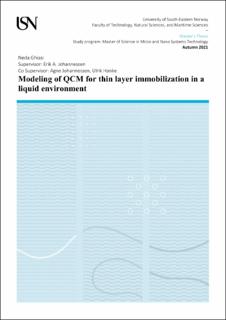| dc.contributor.advisor | Johannessen. Erik | |
| dc.contributor.advisor | Co Suppervisors: | |
| dc.contributor.advisor | Johannessen. Agne | |
| dc.contributor.advisor | Hanke. Ulrik | |
| dc.contributor.author | Ghiasi, Neda | |
| dc.date.accessioned | 2022-03-25T17:41:24Z | |
| dc.date.issued | 2022 | |
| dc.identifier | no.usn:wiseflow:6454744:47713133 | |
| dc.identifier.uri | https://hdl.handle.net/11250/2987753 | |
| dc.description.abstract | In this thesis, we develop two models of a quartz crystal microbalance (QCM) to analyze the system’s behavior in liquid sensing. These models detail the device response concerning the changes in sensor geometry, surrounding medium, and liquid properties variation.
In the first model, we investigate the electrical equivalent circuit of the ideal device in MATLAB. We can predict the resonant frequency with respect to the sensor’s area changes, loading water on top of the sensor, and changes in bulk viscosity and density of the water. The results are reliable and by the experiments.
We simulated another model using finite element analysis (FEM) in COMSOL to examine the system reaction to the changes in sensor radius, liquid loading, and changes in properties of the liquid. In this model, we can check more variables that affect the system operating frequency. The results confirm the previous model achievements with small deviations. Both models provide the grounds for more investigations in the future. | |
| dc.description.abstract | In this thesis, we develop two models of a quartz crystal microbalance (QCM) to analyze the system’s behavior in liquid sensing. These models detail the device response concerning the changes in sensor geometry, surrounding medium, and liquid properties variation.
In the first model, we investigate the electrical equivalent circuit of the ideal device in MATLAB. We can predict the resonant frequency with respect to the sensor’s area changes, loading water on top of the sensor, and changes in bulk viscosity and density of the water. The results are reliable and by the experiments.
We simulated another model using finite element analysis (FEM) in COMSOL to examine the system reaction to the changes in sensor radius, liquid loading, and changes in properties of the liquid. In this model, we can check more variables that affect the system operating frequency. The results confirm the previous model achievements with small deviations. Both models provide the grounds for more investigations in the future. | |
| dc.language | eng | |
| dc.publisher | University of South-Eastern Norway | |
| dc.title | Modeling of QCM for thin layer immobilization in a liquid environment | |
| dc.type | Master thesis | |
